Unplugged: Blueprints of Mad King Ludwig (Boardgame)
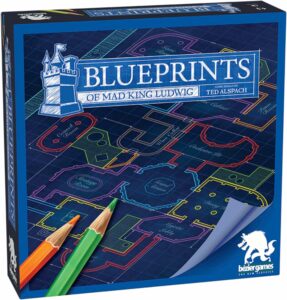 The boardgames of Mad King Ludwig continue to shrink. First we had Castles of Mad King Ludwig where players auctioned tiles, placing them to build their own personal castle. Next came the Palace of Mad King Ludwig (reviewed here) where all players work together to finish only a single castle. Now, there isn’t any building at all, only the blueprints. In Blueprints of Mad King Ludwig, players simply draw out their dreams on a piece of paper, in the hopes of catching the king’s eye and his favor. Players are still placing funny shaped rooms into a castle area, but gone are the auctions and money shenanigans of the original Castles of Mad King Ludwig. This slims the game down and keeps it moving at a quick pace. Your opinion of this “flip and write” game will depend on whether you are willing to give up the greater strategic depth of money auctions and associated shenanigans for a faster-paced and shorter over-all game.
The boardgames of Mad King Ludwig continue to shrink. First we had Castles of Mad King Ludwig where players auctioned tiles, placing them to build their own personal castle. Next came the Palace of Mad King Ludwig (reviewed here) where all players work together to finish only a single castle. Now, there isn’t any building at all, only the blueprints. In Blueprints of Mad King Ludwig, players simply draw out their dreams on a piece of paper, in the hopes of catching the king’s eye and his favor. Players are still placing funny shaped rooms into a castle area, but gone are the auctions and money shenanigans of the original Castles of Mad King Ludwig. This slims the game down and keeps it moving at a quick pace. Your opinion of this “flip and write” game will depend on whether you are willing to give up the greater strategic depth of money auctions and associated shenanigans for a faster-paced and shorter over-all game.
Blueprints of Mad King Ludwig
Designer: Ted Alspach
Publisher: Bézier Games
Players: 1-5
Ages: 15+ (although easily played by a 10 yr old)
Time: 60 min
(review copy provided by publisher)
Blueprints of the Mad King Ludwig is a flip-and-write game where players are trying to fill in their personal castle board by drafting rooms from a central tableau. Each room comes with one or more doorways. Doors don’t need to connect to other doors, but if all doors in a room are connected to doors in other rooms then that room is considered “completed.” The completed room scores points, and perhaps most importantly, grants a special boon (depending the room’s type) to use later in the game. In addition to room and room bonuses, players are also competing to be the “best” in one of several categories (like largest rooms, most of a color, etc…) and to satisfy one or more personal scoring goals (like extra points for small rooms, round rooms, rooms touching the outside, etc…) After 10 rounds of play, the game ends. Players score their completed rooms, any bonuses, and points are awarded for how well players met the special King’s Favor condition cards.
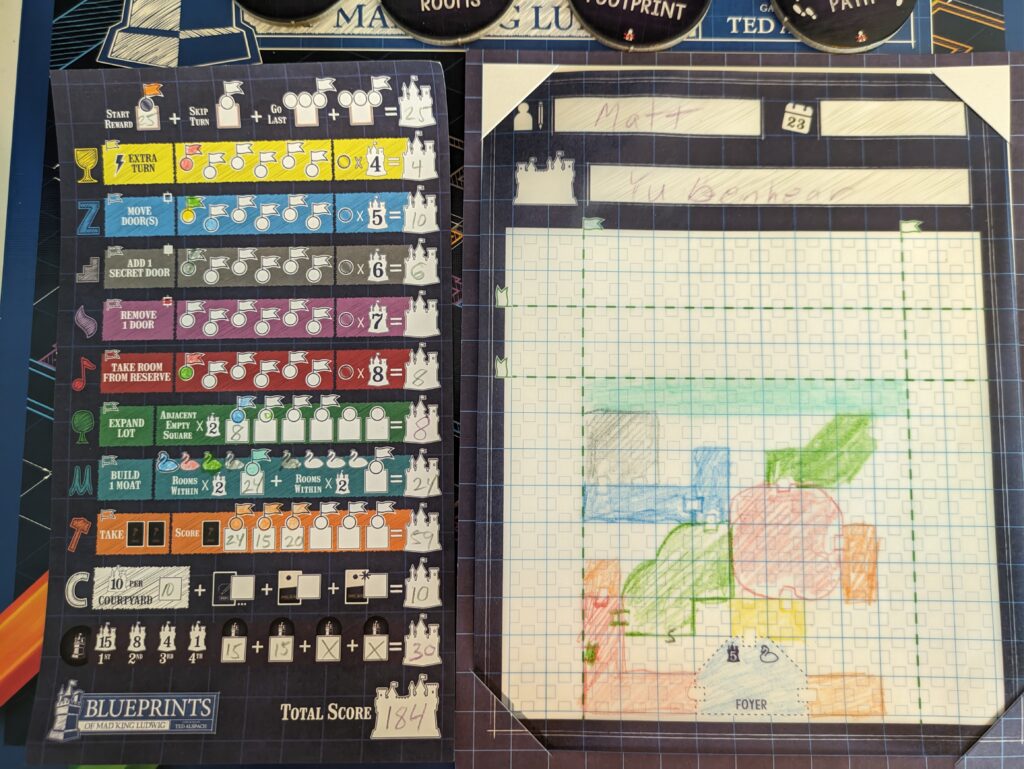
To start the game, players are given a very nice vellum (ie. fancy, semi-transparent) map sheet and a score sheet to track their accomplishments as they draw. It’s important to name your castle before starting (because, why not?) Then, three different randomizers are used to make each game of Blueprints different.
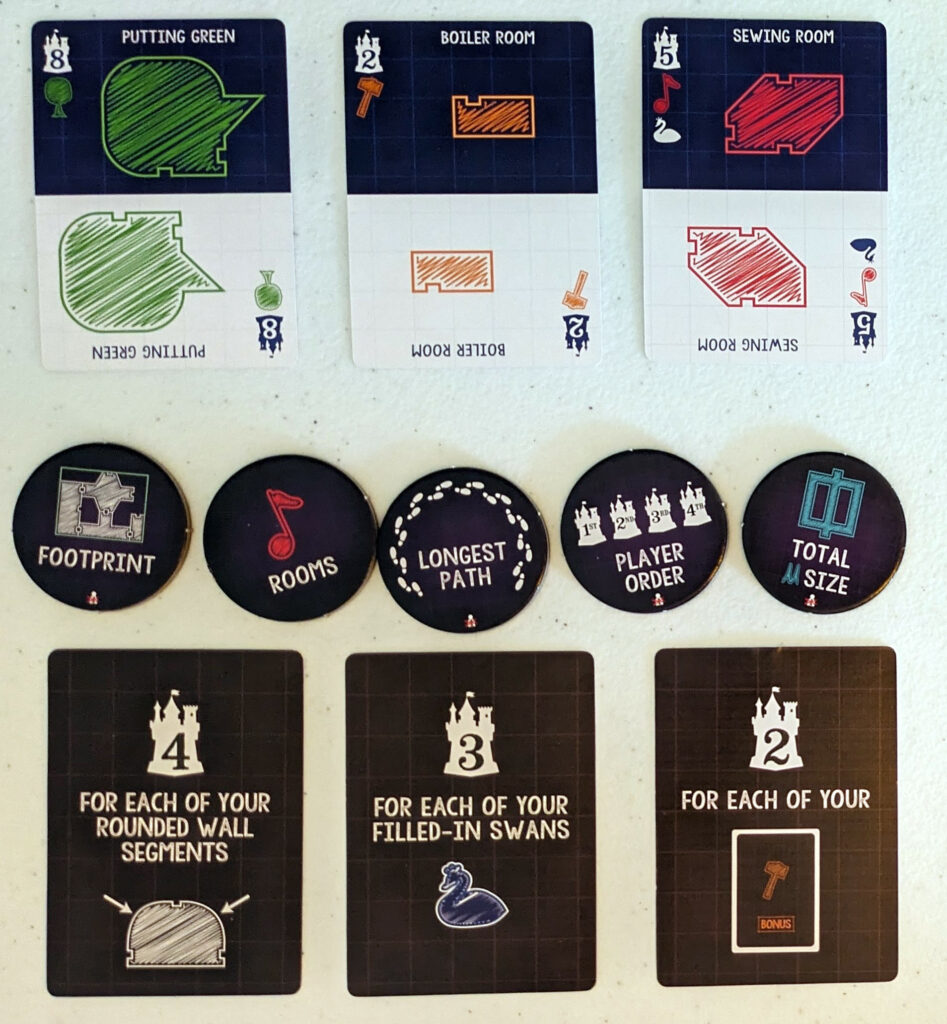
Four King’s Favor tiles are revealed, showing what sorts of things the king is looking for in his castle. There are a large range of favor tiles, things like most square footage of a type, most variety of something, largest footprint, longest path through rooms, etc… Players will earn points at the end of the game according to how they place in each category. Players are dealt two personal bonus cards which grant additional ways to score points. These include points for specific sizes or colors of rooms, rooms touching other rooms, and some far-out ones like points if you only use one bonus card, points for a set of all 8 sizes of rooms, etc… Finally, players draft a Royal Decree from a set of cards. This is a personal special power that sets a player apart from all the others. These range from adding extra points (for courtyards, for special room pairings, etc…) to special powers (like setting a room aside for later, ignoring blocked doorways, or more powerful versions of a room’s special power.) Finally, players color in their starting room (the foyer) to give it a color – it will provide that color’s power when it is completed. Oh, and give everyone a swan in their foyer color (more on that later.)
Once all the bits are laid out, the game begins with revealing a tableau of room cards – two more cards than the number of players. In turn order (determined by the player who placed the largest room last round) players choose a room and then sketch it onto their cool vellum sketchpad. Here the pad struts it’s stuff. The cards fit nicely under the vellum and can be easily traced over. Rooms can be rotated and each room card displays a room on the top and its mirror image on the bottom of the card – either can be chosen.) Rooms must connect at least one of their doors to a previously drawn door, they can’t overlap other rooms, and they must stay within the bounds of the castle borders. (Note, the borders can be expanded during the game when certain rooms are built.) At the end of the round, the remaining two cards are discarded. A new tableau is dealt and play continues for a total of 10 rounds (governed by the number of rooms in the deck.)
The heart of the game is drawing rooms, of course. Drawing them into your castle is one thing, but to score points you want to complete them. To complete a room,
- Food Rooms (Yellow, 4 pts) – Take an extra turn. Choose another room from the tableau after everyone else has taken their first on this turn.
- Sleeping Rooms (Blue, 5 pts) – When drawing a room, may rearrange any and all doors on the room being drawn.
- Downstairs Rooms (Grey, 6 pts) – Add a secret passage to a room. This can be used to fix a previous blocked connection or to make a new one. Any further Downstairs rooms need to be attached to a downstairs room. *Note, secret doors do not prevent a room from being completed so a secret door to a courtyard can score points even while the adjoining room scores as a completed room.
- Living Rooms (Purple, 7 pts) – You may remove an entrance on a previously drawn room. This can make it easier to complete a room.
- Activity Rooms (Red, 8 pts) – You may select a card from the discard pile instead of the tableau when taking a room card. *This can be useful if several people score extra actions and the tableau is used up.
- Outdoor Rooms (Green, * pts) – Completing an outdoor room allows a player to expand their drawing space. Additional space can be added on either side and in two additional layers on top. Completed green rooms score points based on how many white (unfilled) squares are adjacent to the room. 2 points for a full square, 1 point for a half-square (like a curve or an angle.)
- Moats (Aqua, * pts) – Once a player has four swan symbols (these appear on some room cards) they can, at any time in the future, draw a moat on their board. Doors next to the moat are not completed. Nor can moats be used in joining future rooms. However, any room completely “behind” a moat will score two points in final scoring.
- Utility Rooms (Orange) – Draw two new Bonus Cards from the deck. More importantly, you also score one Bonus Card at the end of the game. *This means you score no bonus cards if you never get/use an orange completion bonus. (From an orange room or elsewhere.)
- Courtyards – Not a room, but if you completely surround a white space with rooms AND manage at least one entrance into the white space from a room, it is considered a courtyard and scores 10 points in final scoring.
There are a couple of fiddly bits on the scorepad that allow players to access additional, “free” room completion rewards of their choice. These can be used at any time a regular room completion reward would happen. First, all players are given one wildcard completion reward at the start of the game. A player gains another one if they ever choose to pass in a round (not take a card.) Finally, a player can earn another free reward every three times they manage to pick last in a round.
Verdict:
When I look at Blueprints of Mad King Ludwig I really see two different games here. First, there is a multiplayer game where players are drafting (or hate-drafting if they are trying to deny someone’s best choice) rooms and competing over the King’s Favors throughout the game. Like many roll/flip & write games, players are primarily going to be playing around in their own little “sandbox” as they draw their rooms out. However, there are many points given out at the end of the game for “best” in the four categories. A player will be hard pressed to win without placing well in at least two or three of these. Thus, even though everyone has their own play area, the race aspect of the game means that other players’ blueprints cannot just be ignored. Also somewhat unique in the flip/roll and write genre, all players do not use the same card each round. The draft ties players together as players have to weigh carefully which room they pick. Is it best for their castle, is a particular room good for another player (and therefore good to “steal”) or perhaps even picking a larger room this round to give one a better pick next round?
At only ten rounds, the game plays at a pleasantly fast clip. Using the occasional extra turn will mean most blueprints end up with 11 or 12 rooms. However, the flip side of a speedy game means I sometimes feel like I’m just starting to get things going. The game ends before I want it to. The argument can be made that this is a feature not a bug. However you see it, the swift ending is something to be aware of – players need to prioritize their choices in those last 2 or three turns or they’ll leave too many rooms unfinished.
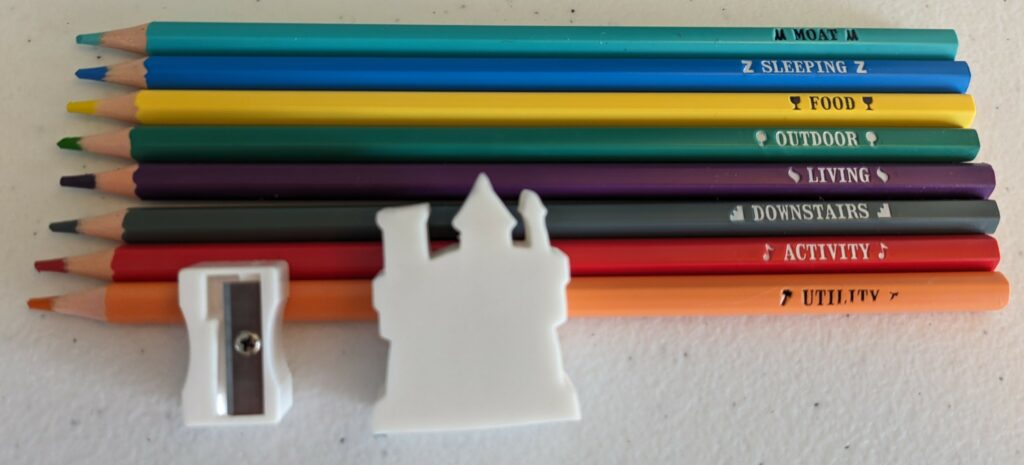
While I’m not one to harp on game components, the bits and bobs in Blueprints do deserve a special mention. Yes, one can go on the Bezier web site and print out extra paper scoresheets but the transparency of the vellum scoresheets is very cool. Having the room and the mirror image of the room on the same card, at the same scale as the blueprints is great. The ability to slip the room card under the vellum and trace it out is a great help to those poor struggling drafters. I’m typically a “lets laminate this roll & write to make it reusable” but I’m not sure I will do so in this case. The game provides nice colored pencils optimized for the paper along with an eraser (shaped like a castle of course) and pencil sharpener (as explained in the rulebook, don’t use just any sharpener for the pencils.) To complete the set, the pencils all have the correct room name printed on them. The designer diary mentions the search for a great set of pencils and paper on which to write. (You need a dark enough yellow to see that it isn’t too close to orange, that isn’t too close to red…) I can give props to all the effort – the act and feel of drawing but I do wish the colors were somehow darker. Blueprints, as it stands, is not conducive to dim lighting.
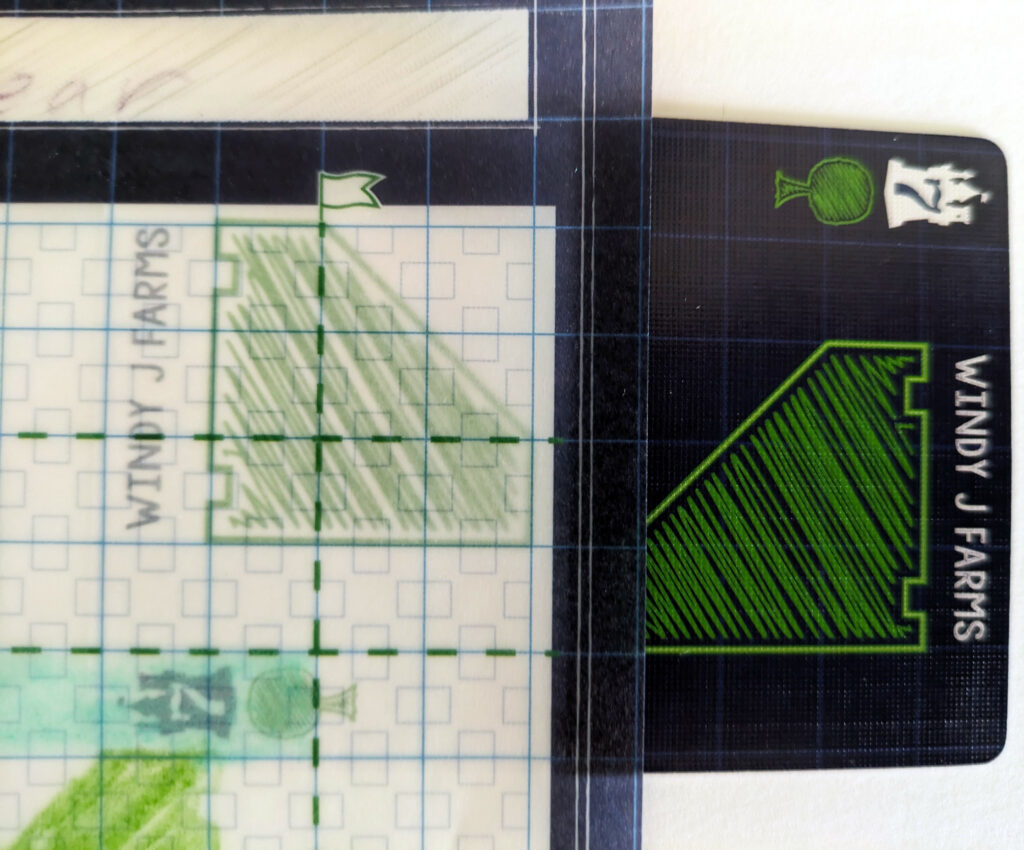
Any roll/flip and write game will have it’s share of randomness. Here there are many. Every game will be different. There are dozens of different King’s Favors, Bonus Cards, and Royal Decrees. No two games will ever be alike. I find the Royal Decrees to be a nice touch. Giving each player a “special ability” separates the pack at the start, but also makes playing the game just a little bit different. A game with one Royal Decree may play much differently than one with a different decree. This variability is a great asset. However, it bites both ways. There are 76 room cards. With high player counts, you will see most of those come out. However, a two player game will only see half of them and a solo game sees even less. Sometimes a player’s Favors, Decrees, and Bonus cards all lean towards a few types of cards and if they simply aren’t showing up it can be a frustrating game. For this reason, I actually like the game better with 3 or more people. As long as no one person is particularly slow, games with higher player counts still progress at a good clip.
Speaking of solo play, Blueprints has an excellent solo mode. Players start by drafting Favors, Decrees, and Bonus cards as normal (more or less) but exclude any of those that simply aren’t going to work well in a solo game. The game plays out as normal, with three rooms available each round. The solo player picks one and the other two go into a “Reserve pile.” At the end of the game the solo player scores points for any of the Royal Favors where they exceed the value of the accumulated cards in the reserve. There is no win or loss in solo gaming, just a final score which is compared to a ranking chart in the rulebook. I thought I was doing well in my first game but ended up with a score in the middle. As mentioned before, seeing a bit more than a third of the room cards can make the solo game a bit swingy – the rooms you need for bonus cards just might not come up. The Favor race isn’t as bad because any rooms you pick up yourself aren’t going into the reserve pile. If you aren’t seeing them, they’re not going into the reserve either.
There is an obvious comparison to the “original” Castles of Mad King Ludwig game. Blueprints captures most of the core gameplay, but in a much shorter timespan. Rather than a straight room draft, the original game had an auction and therefore a whole money management aspect. Rooms also had much greater interdependencies – many of them added (or subtracted) points based on the rooms connecting to them. As much as I love the idea of money management, I think the tradeoff for a faster game makes up for the lightweight strategy. Bonus points for it coming in a smaller box and taking up much less table space to play.
For now, Blueprints will remain in my collection. It works well as a solo game (provided I’m comfortable with no specific win/loss condition) and for groups of 3 or more. At two players, I don’t like how a game could end up favoring some specific colors and sizes over others. It’s a bit complicated for casual gaming, but that also means it’s a good candidate for a “super-filler” – a fast-playing game of medium complexity. A solid, but quick game that fits nicely into an evening of several games.
Kid Factor:
There is a lot going on in this game but not so much that an astute middle school child wouldn’t be able to master. Almost all the important text is conveyed through icons so even reading isn’t a particularly important skill. One is just drawing out a bunch of shapes so there’s no parental advisory needed. In fact, one could argue that tracing shapes and fitting them into patterns would be quite educational. The game might inspire curiosity about the man himself, but don’t expect the game to teach anything historical.





Discussion Area - Leave a Comment